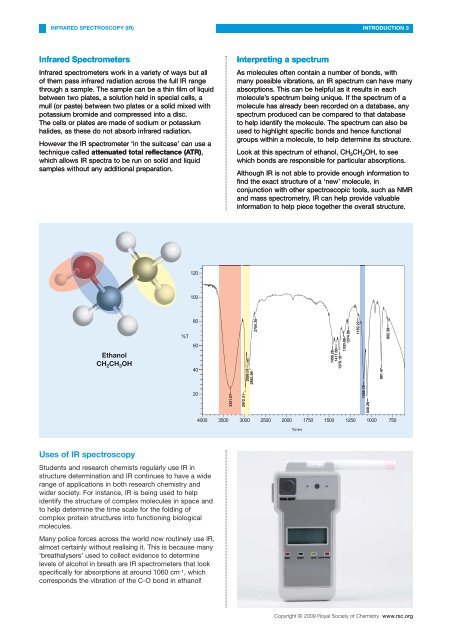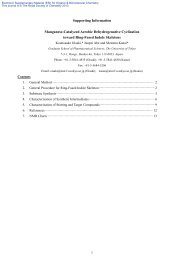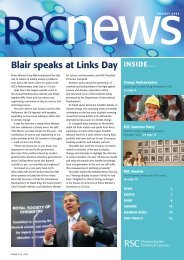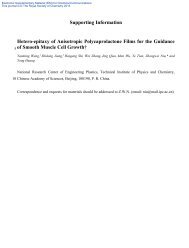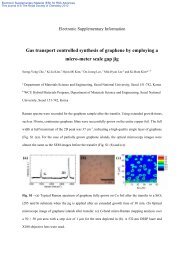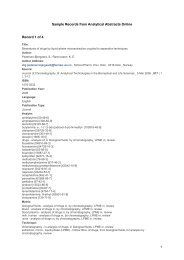Spectroscopy in a Suitcase - Royal Society of Chemistry
Spectroscopy in a Suitcase - Royal Society of Chemistry
Spectroscopy in a Suitcase - Royal Society of Chemistry
Create successful ePaper yourself
Turn your PDF publications into a flip-book with our unique Google optimized e-Paper software.
INFRARED SPECTROSCOPY (IR)<br />
INTRODUCTION 3<br />
Infrared Spectrometers<br />
Infrared spectrometers work <strong>in</strong> a variety <strong>of</strong> ways but all<br />
<strong>of</strong> them pass <strong>in</strong>frared radiation across the full IR range<br />
through a sample. The sample can be a th<strong>in</strong> film <strong>of</strong> liquid<br />
between two plates, a solution held <strong>in</strong> special cells, a<br />
mull (or paste) between two plates or a solid mixed with<br />
potassium bromide and compressed <strong>in</strong>to a disc.<br />
The cells or plates are made <strong>of</strong> sodium or potassium<br />
halides, as these do not absorb <strong>in</strong>frared radiation.<br />
However the IR spectrometer ‘<strong>in</strong> the suitcase’ can use a<br />
technique called attenuated total reflectance (ATR),<br />
which allows IR spectra to be run on solid and liquid<br />
samples without any additional preparation.<br />
Interpret<strong>in</strong>g a spectrum<br />
As molecules <strong>of</strong>ten conta<strong>in</strong> a number <strong>of</strong> bonds, with<br />
many possible vibrations, an IR spectrum can have many<br />
absorptions. This can be helpful as it results <strong>in</strong> each<br />
molecule’s spectrum be<strong>in</strong>g unique. If the spectrum <strong>of</strong> a<br />
molecule has already been recorded on a database, any<br />
spectrum produced can be compared to that database<br />
to help identify the molecule. The spectrum can also be<br />
used to highlight specific bonds and hence functional<br />
groups with<strong>in</strong> a molecule, to help determ<strong>in</strong>e its structure.<br />
Look at this spectrum <strong>of</strong> ethanol, CH 3 CH 2 OH, to see<br />
which bonds are responsible for particular absorptions.<br />
Although IR is not able to provide enough <strong>in</strong>formation to<br />
f<strong>in</strong>d the exact structure <strong>of</strong> a ‘new’ molecule, <strong>in</strong><br />
conjunction with other spectroscopic tools, such as NMR<br />
and mass spectrometry, IR can help provide valuable<br />
<strong>in</strong>formation to help piece together the overall structure.<br />
Ethanol<br />
CH 2 CH 3 OH<br />
Uses <strong>of</strong> IR spectroscopy<br />
Students and research chemists regularly use IR <strong>in</strong><br />
structure determ<strong>in</strong>ation and IR cont<strong>in</strong>ues to have a wide<br />
range <strong>of</strong> applications <strong>in</strong> both research chemistry and<br />
wider society. For <strong>in</strong>stance, IR is be<strong>in</strong>g used to help<br />
identify the structure <strong>of</strong> complex molecules <strong>in</strong> space and<br />
to help determ<strong>in</strong>e the time scale for the fold<strong>in</strong>g <strong>of</strong><br />
complex prote<strong>in</strong> structures <strong>in</strong>to function<strong>in</strong>g biological<br />
molecules.<br />
Many police forces across the world now rout<strong>in</strong>ely use IR,<br />
almost certa<strong>in</strong>ly without realis<strong>in</strong>g it. This is because many<br />
‘breathalysers’ used to collect evidence to determ<strong>in</strong>e<br />
levels <strong>of</strong> alcohol <strong>in</strong> breath are IR spectrometers that look<br />
specifically for absorptions at around 1060 cm -1 , which<br />
corresponds the vibration <strong>of</strong> the C-O bond <strong>in</strong> ethanol!<br />
Copyright © 2009 <strong>Royal</strong> <strong>Society</strong> <strong>of</strong> <strong>Chemistry</strong> www.rsc.org


